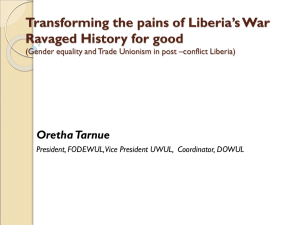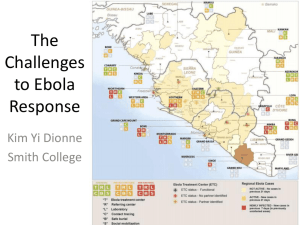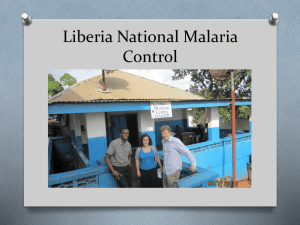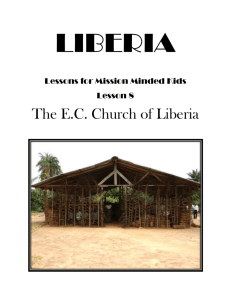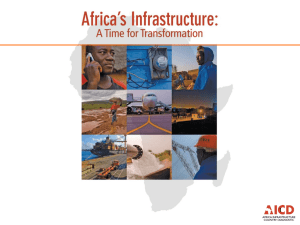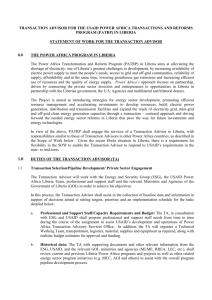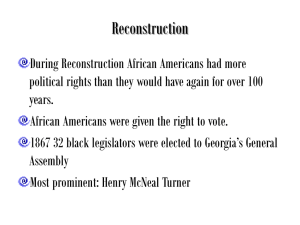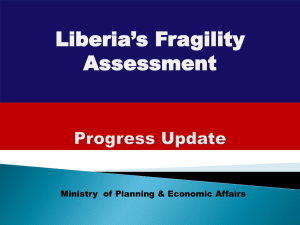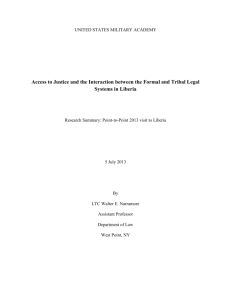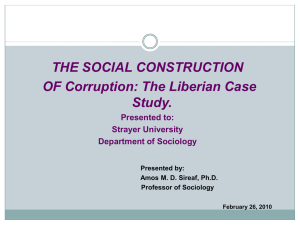3. Day 1. Session 4. Liberia Presentation.MIA
advertisement
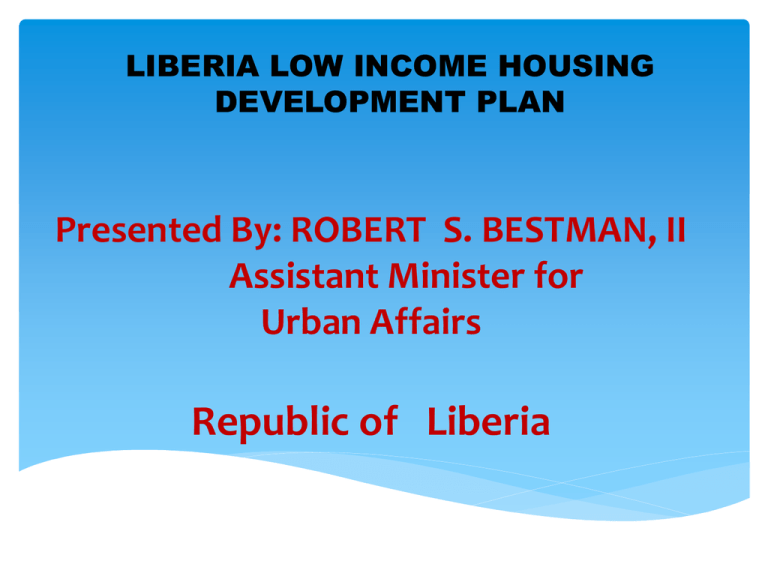
LIBERIA LOW INCOME HOUSING DEVELOPMENT PLAN Presented By: ROBERT S. BESTMAN, II Assistant Minister for Urban Affairs Republic of Liberia The Country Liberia Liberia is a nation in transition following a protracted period of a devastating internal armed conflict. Currently, Liberia has the population of about 3.7 million , which 2.2 millions are urban inhabitants. Urban population. growth rate is estimated at 5.6% per annual which indicates that most Liberian now reside in urban centers. Hence, urban housing remain a major challenge in Liberia. Programs initiated by Government to address the housing needs include but not limited to: Liberia Rising 2030 and the Agenda for Transformation (AFT), which articulate the broad national aspiration to be achieved by 2030 and provide a medium term growth and development in the “transformation of Liberia into a middle-income country with equal opportunities and access to all by the year 2030”. VISION 2030 -Agenda for Transformation The Agenda for Transformation (Republic of Liberia) sets out how government intends to move the country forward from war through recovery and reconstruction to inclusive growth and wealth creation to become a Middle Income Country by 2030. The Agenda for Transformation (AFT) specific housing objectives are: Expanding access to affordable housing for low income earners. Improving housing policy, clarifying public and private-sector roles and assuring affordability and community participation. Housing: Low Income Housing in Liberia Housing is a basic human need and a major determinant of social and economic development for Liberia’s post conflict recovery program. The National Housing Authority (NHA) was established by the government of Liberia to attend to the housing needs of our population. However, mush attention has not be adequate to the housing sector in the past, since the civil conflict due to the country’s low budget envelope at the overall. This has lead to an increase in rental for the less available (Housing) in urban areas. Cont. The housing stock is inadequate and generally poor and the proportion of the population living in urban slums is on the rise Currently, there is a policy and strategies being develop to pursue housing development on a sound and sustained basis. Given this state of housing and human settlements in my Country, the government of Liberia has embarked on a mission to re-invent and re-position the government institution (NHA) to meet the housing development needs of a post, conflict Liberia undergoing re-construction and renewal. LIBERIA’S HOUSING STRATEGIC DIRECTION The government of Liberia through the NHA has purposefully chosen to pursue over the next five years (2013 – 2017), a plan that seeks to achieve the following strategic objectives through the identified core actions: Housing Development Policy and Strategy Housing Development Finance Standards for Housing Land for Housing Development Construction Technology Town/City Planning Cost & Implementation Cost of Low Income Housing Plan Total cost of the Plan is put at US$6,665,000 (Six million, Six Hundred Sixty Five Thousand United States Dollars) over the five year period. The Government of Liberia is expected to make a substantial contribution of 30% (1,999,500) towards this cost. The goodwill of donors and bilateral partners is solicited to underwrite the balance 70%, (4,665,500) to buttress the efforts of government in ensuring the full implementation of the plan. Detail Analysis on Housing Project No. Cost Centre Estimated Cost (US$) 100,000 1 Development of a Housing Policy and Strategy 2 Housing Development Finance 3 Standard for Housing 335,000 4 Land for Housing Development 650,000 5 Construction Technology 6 Town/City Planning 7 Institutional Development 8 Plan Implementation Total 1,810,000 1,525,000 420,000 1,225,000 235,000 6,665,000 Resource Mobilization The Plan is expected to be financed by the Government of Liberia, through budgetary and other support to the National Housing Authority, and support from international donors and development partners. It is estimated that the Government will initially commit US$2 million over the next three (3) years to this effort. To guide the entire process of resource mobilization, the NHA will develop and implement a resource mobilization strategy that will seek funding from both local and external funding sources. Achievements of Urban housing in Liberia The Liberia Government through the National Housing Authority, between 1962 and 1984, developed and implemented a number of housing programs in Liberia to address urban housing needs of our growing urban population. As the following matrix shows, these housing investments amounted to US$39.6 million and produced 1,789 housing units and 600 plots for low-cost housing development. Matrix on Low Income Housing Units Housing Projects Year of Construction No. of Units Investment Cost (in US$) Source of Funding New Kru Town 1962 25 125,000 Amilcar Cabral 1973/74 72 1,117,782 Stephen A. Tolbert E. J. Goodridge 1975/79 1976/77 442 604 7,598,682 9,385,315 Int’l Trust Company (ITC) GoL/Gov’t of Norway Gov’t of Norway Gov’t of Liberia New Georgia 1978/79 263 1,852,798 GoL/Citibank Old Matadi 1978/80 191 11,732,600 USAID West Point 1980 32 1,054,000 USAID Sites/Services 1982/86 600 plots 2,206,000 USAID New Matadi 1984 72 3,000,000 LPRC Buchanan 2011/12 10 178,166.66 NOCAL Voinjama 2011/12 10 178,166.66 NOCAL Sanniquellie 2011/12 10 178,166.66 NOCAL Brewerville 2012/13 58 1,000,000 NASSCORP Land available for Low Cost Housing Unit № County 1. 2. 3. 4. 5. 6. 7. 8. 9. 10. 11. 12. 13. 14. 15 Total Montserrado (Rural) Grand Bassa Sinoe Grand Cape Mount Bong Margibi Grand Geddeh Nimba Lofa Grand Kru Maryland Rivercess Gbarpolu River Gee Bomi Total Land Acquisition Mandated (in acres) Actual Land Acquired (in acres) Current Shortfall (in acres) 700 300 300 300 300 300 300 300 300 300 300 300 300 300 300 4,900 550 52 0 0 0 398 50 10 10 0 0 0 0 0 15 1,085 150 248 300 300 300 +98 250 290 290 300 300 300 300 300 285 3,717 CHALLENGES Low funding for operations and investment in social housing plus sites and services infrastructure Lack of investment in sites and services infrastructure as is done in other neighbouring countries has shifted the interest of serious housing sector investors to those countries. Long term funding for mortgage financing. Up to 2012, very little long-term lending activity has occurred in the Liberian financial system with the average tenor of loans being less than 3 years. Cont. The urban setting capacity in Liberia and access to resources have suffered seriously as a result of the numerous civil conflicts in Liberia since the late 70s, particularly the 14-year civil war (1989 to 2003). Efforts to reverse the situation have been limited due to lack of funding to recruit, develop, and maintain the level of skills and experience needed to make the entity more responsive to its mandate. Monitoring and Evaluation The plan will lend itself to continuous monitoring and learning from experiences. Progress reports will be derived from semi-annual reviews. The plan will be externally evaluated to gauge its effectiveness and adjusted where necessary. Finally, a mechanism will be put into place to capture relevant data and information based on identified indicators, verifiers, and sources of information. Practical View of an ongoing Urban Housing project Brewerville Site Project Beginning Stage Completion Stage Eco-Homes Liberia A housing construction company involved in construction of low income earners home in Liberia Construction Site on the Roberts International Airport high-way Thanks. Liberia welcomes the intervention of all foreign partners to the ongoing development initiatives
